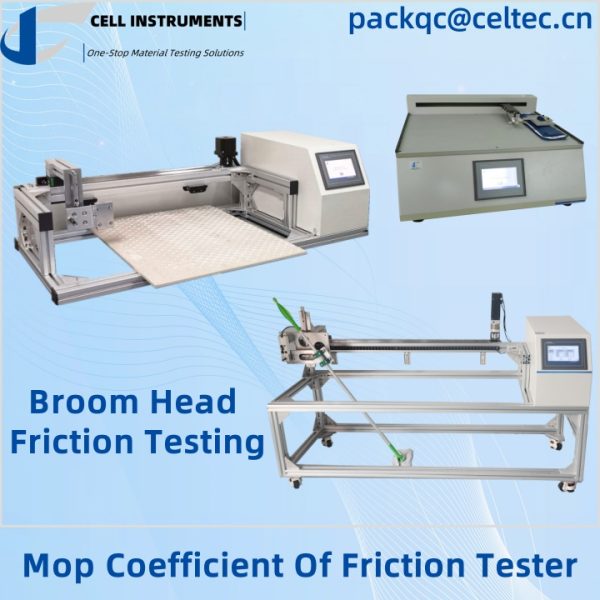How Mop Coefficient of Friction Tester Enhances Cleaning Material Performance
Introduction
In industries where the cleaning efficacy of materials is critical, testing tools like the mop coefficient of friction tester are indispensable. This device helps manufacturers and quality control teams assess how well a mop or cleaning tool performs under real-world conditions, ensuring that it meets strict performance standards. From household mops to industrial cleaning products, accurate friction testing can significantly impact product quality, longevity, and customer satisfaction.
The mop coefficient of friction tester offered by Cell Instruments plays a key role in this testing process. Designed to measure the frictional forces between cleaning materials and various surfaces, this tool ensures that products not only meet but exceed industry expectations. Additionally, secondary tests like the broom head friction test further validate the quality of various cleaning tools.
Importance of Mop Coefficient of Friction Testing
Friction testing provides valuable insights into the interaction between cleaning tools and surfaces. The mop coefficient of friction tester measures how much force is required to move a mop or broom across a surface, providing data that helps optimize material selection and product design. A high coefficient of friction typically indicates a mop’s enhanced cleaning efficacy, while a lower coefficient might suggest ease of movement but potentially reduced cleaning power.
Applications Across Industries
- Home Cleaning Products: Ensures that household mops provide effective cleaning without requiring excessive force.
- Office and Industrial Cleaning Materials: Validates the performance of industrial-grade cleaning materials in demanding environments.
- Medical and Pharmaceutical: Critical in sterile environments where hygiene is of utmost importance.
Broom Head Friction Test: A Key Secondary Measure
The broom head friction test is an important aspect of cleaning product evaluation, as it assesses the frictional resistance specifically between broom heads and various flooring materials. This test helps ensure that brooms can perform optimally without excessive wear on the broom head or the surface.
For manufacturers, the data obtained from these tests help fine-tune the design of cleaning products, ensuring a balance between performance and durability. At Cell Instruments, the mop coefficient of friction tester offers seamless integration of both mop and broom head friction testing, providing a comprehensive solution for cleaning product evaluation.
Benefits of Using a Mop Coefficient of Friction Tester
Investing in a mop coefficient of friction tester offers numerous benefits to cleaning product manufacturers:
- Enhanced Product Quality: Testing ensures that mops and brooms are built to meet or exceed cleaning performance standards.
- Improved Product Development: Manufacturers can use friction data to innovate and refine their products.
- Reduced Waste and Cost: Early detection of performance issues in cleaning tools can reduce material waste and production costs.
Features of the Cell Instruments Mop Coefficient of Friction Tester
Cell Instruments’ mop coefficient of friction tester combines innovative design with cutting-edge technology, offering high-precision testing for cleaning materials. Below are the key features:
- 7-inch Human-Machine Interface (HMI): User-friendly interface for easy operation.
- PLC Industrial Control System: Ensures stability and precise test execution.
- High-Precision Loadcell: Measures friction force with 0.5% accuracy.
- Adjustable Testing Speed: Users can customize the testing speed from 1 to 60,000 mm/min, depending on their specific requirements.
How to Perform Mop Coefficient of Friction Testing
Testing with a mop coefficient of friction tester involves several key steps:
- Securing the Sample: The cleaning material sample is attached securely to the tester.
- Setting the Test Parameters: Adjust the test speed and apply the desired amount of pressure to simulate real-world conditions.
- Running the Test: The machine performs multiple cycles to simulate repeated use.
- Data Collection and Analysis: Friction force data is collected in real time, allowing users to assess the material’s performance.
Why Choose Cell Instruments?
Cell Instruments is committed to providing high-quality testing equipment that meets the specific needs of its clients. With customizable options and cutting-edge technology, our mop coefficient of friction tester is designed to help manufacturers deliver superior cleaning products that excel in both performance and durability.
Testing cleaning materials is essential for ensuring quality, and a mop coefficient of friction tester is a key tool in this process. By providing accurate friction data, the tester helps manufacturers optimize their products for better cleaning efficacy and durability, leading to improved customer satisfaction and reduced environmental impact.
FAQ
1. What is the mop coefficient of friction tester used for?
The mop coefficient of friction tester is used to measure the frictional forces between a mop or cleaning tool and various surfaces, ensuring the tool’s cleaning efficacy.
2. How does broom head friction testing differ from mop friction testing?
Broom head friction testing specifically assesses the resistance between the broom head and the surface, while mop friction testing covers the entire mop.
3. Can the testing speed of the mop friction tester be adjusted?
Yes, the Cell Instruments mop friction tester allows for adjustable testing speeds ranging from 1 to 60,000 mm/min.
4. Why is friction testing important for cleaning products?
Friction testing ensures that cleaning products perform effectively without causing excessive wear on surfaces or requiring too much effort.
5. Is customization available for the mop coefficient of friction tester?
Yes, Cell Instruments offers software, program, and fixture customization to meet specific testing needs.
Related Products
Related Article
Reference

